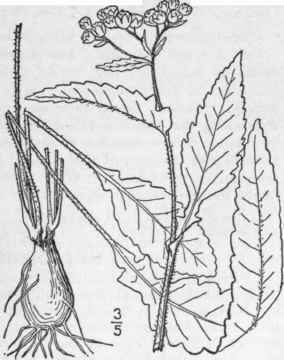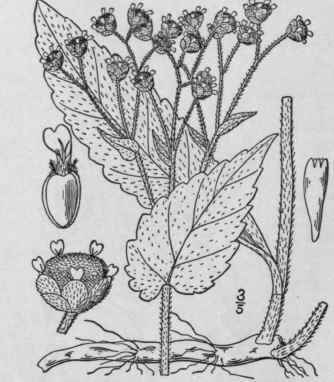55. Parthenium L. Sp. Pl. 988. 1753
Description
This section is from the book "An Illustrated Flora Of The Northern United States, Canada And The British Possessions Vol3", by Nathaniel Lord Britton, Addison Brown. Also available from Amazon: An Illustrated Flora of the Northern United States, Canada and the British Possessions. 3 Volume Set..
55. Parthenium L. Sp. Pl. 988. 1753
Perennial, mostly pubescent or canescent herbs, or shrubs, with alternate leaves, and small corymbose or paniculate heads of both tubular and radiate white or yellow flowers. Involucre broadly campanulate or hemispheric, its bracts imbricated in 2 or 3 series, obtuse, appressed, nearly equal. Receptacle convex or conic, chaffy, the chaff membranous, surrounding the disk-flowers. Ray-flowers about 5, pistillate, fertile, their ligules short, broad, 2-toothed or obcordate. Disk-flowers perfect, sterile, their corollas 5-toothed, the style undivided. Anthers entire at the base. Achenes compressed, keeled on the inner face, margined, bearing the persistent rays on the summit. Pappus of 2-3 scales or awns. [Greek, virgin.]
About 12 species, natives of North America, Mexico, the West Indies and northern South America. Besides the following, some 3 others occur in the southern and southwestern United States. Type species: Parthehium Hysterophorus L.
Leaves 1-2-pinnatifid; annual weed.
Leaves crenate-dentate, or somewhat lyrate; perennials.
1. P. Hysterophorus.
Stem glabrous, or pubescent or puberulent above; rootstock tuberous-thickened.
2. P. integrifolium.
Stem hirsute or villous.
Stem leaves auricled, clasping at base; rootstock thick.
3. P. auriculatum.
Stem leaves sessile, not auricled; rootstock long, slender.
4. P. Hispidum. 1. Parthenium Hysterophorus L. Santa Maria
Fig. 4432
P. Hysterophorus L. Sp. Pl. 988. 1753.
Annual, strigose-pubescent or somewhat villous, usually much branched, 1°-21/2° high. Leaves ovate to oblong in outline, 1-2-pinnately parted into linear or lanceolate toothed or pinnatifid segments, thin and flaccid; heads numerous, 21/2"-3" broad; involucre saucer-shaped, its bracts concave, the outer ones rhombic, the inner broader; ray-flowers few; rays reniform, white, about \" wide; achenes obovate, about i" long.
Waste and cultivated grounds, southern Pennsylvania to Illinois, Missouri, Florida and Texas. Throughout tropical America. July-Sept.


2. Parthenium Integrifolium L. American Fever-Few. Prairie Dock
Fig. 4433
P. integrifolium L. Sp. Pl. 988. 1753.
Stem stout, striate, finely pubescent with short hairs, or glabrous below, corymbosely branched above, 1°-4° high. Rootstocks tuberous thickened; leaves firm, ovate or ovate-oblong, acute or acuminate, crenate-dentate or somewhat lyrate at the base, hispidulous and roughish on both sides, the lower and basal ones petioled, often 12' long and 5' wide, the upper smaller, sessile; heads numerous in a dense terminal corymb; involucre nearly hemispheric, about 3" high, its bracts firm, the outer oblong, densely appressed-pubes-cent, the inner broader, glabrous, or ciliate on the margins; rays white or whitish.
In dry soil, Maryland to Minnesota, south to Georgia, Missouri and Arkansas. Cutting-almond. Wild quinine. May-Sept.
3. Parthenium Auriculatum Britton. Auricled Parthenium
Fig. 4434
P. auriculatum Britton, in Britt. & Brown, 111. Fl. 3: 521. 1898.
Rootstock an oval erect tuber twice as long as thick; stem villous-pubescent, 1 1/2°-2 1/2° high. Leaves rough above, villous, especially on the veins beneath, oval, ovate or oblong, irregularly crenate-dentate, some or all of them laciniate or pinnatifid at the base, the basal and lower slender-petioled with petiole as long as the blade, or longer, the upper with a sessile clasping auricled base, or with margined clasping petioles; inflorescence densely corymbose, its branches villous-tomen-tose; bracts of the involucre densely canescent.
Mountains of Virginia.


4. Parthenium Hispidum Raf. Creeping Or Hairy Parthenium
Fig. 4435
Parthenium hispidum Raf. New Fl. N. A. 2: 35. 1836.
P. repens Eggert, Cat. Pl. St. Louis 16. 1891.
Similar to the two preceding species, but lower, seldom over 2° high. Rootstocks slender, forming runners; stem pilose or hispid with spreading hairs; leaves hispid on both sides, irregularly crenate, sometimes lyrate at the base, the teeth rounded and obtuse; heads fewer, slightly larger, in a small loose corymb; outer bracts of the involucre proportionately broader.
Barren rocky soil, Missouri to Kansas and Texas. April-July.
Continue to:


